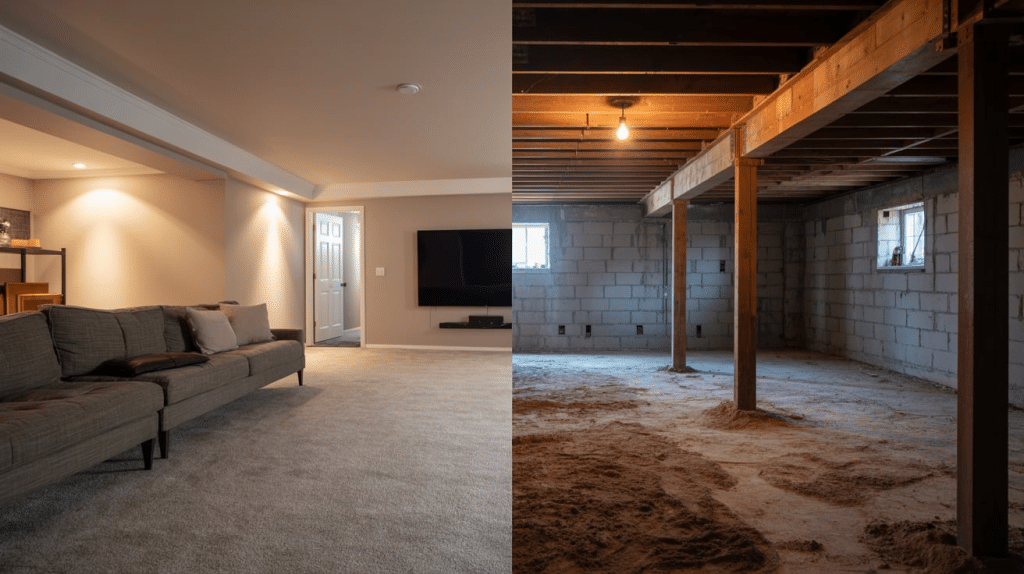I’ve been thinking lately about ways to add more space to my home, and one question kept coming up: can you add a basement to a house that’s already built?
The short answer is yes, but I’ve learned it’s not a simple project. It takes careful planning, the right conditions, and a skilled team to get it done. The costs can also be high, so it’s not something to jump into without weighing your options.
In this post, I’ll share what I’ve found about adding a basement, how to tell if your home is a good fit, the methods contractors use, and what it might cost. By the end, you’ll have what you need to decide with confidence.
Can You Add a Basement to a House?
Yes, you can add a basement to most existing homes. But several factors determine if it’s actually doable for your specific property.
The success of your project depends on your home’s foundation type. It also relies on the soil conditions under your house. Your local building codes play a big role, too.
Some homes are better candidates than others. Homes with crawl spaces often work well for basement additions. Houses built on concrete slabs face more challenges.
Foundation Type
Before moving forward, it’s worth looking at your home’s foundation type, since some make the project much easier while others can be far more challenging. Here are some situations you might find yourself in:
- Homes with crawl space foundations are usually the best candidates. The space already exists under your house. Contractors can work with the existing structure more easily.
- Slab-on-grade foundations create more problems. The concrete slab sits directly on the ground. Adding a basement means breaking through this slab completely.
- Basement foundations might seem like they’d work well. But if you already have a partial basement, extending it requires careful planning.
Soil Conditions
The type of soil beneath your home can make a big difference when adding a basement, as some soils are stable and easy to work with, while others can cause major challenges. These are some soil conditons to observe:
- Clay soil can shift and move over time. This creates problems for new basement walls. Sandy soil drains well but may not provide strong support.
- Rocky soil is often ideal for basement construction. It provides solid support and good drainage. However, rocky soil is also expensive to excavate.
Your contractor will need to test your soil before starting. This testing reveals the soil’s bearing capacity and drainage properties.
Structural Integrity
Your existing house must be strong enough to handle the construction process.
Adding a basement means digging under your current foundation. This temporarily weakens the support for your home. Your house needs enough structural strength to stay stable during construction.
Older homes might need reinforcement before a basement addition can begin. This adds extra time and cost to your project.
A structural engineer should evaluate your home first. They’ll determine what reinforcement might be needed.
Local Building Codes
Every city and county has different rules about basement additions.
Some areas don’t allow basement construction at all. Others have strict requirements about depth and drainage. You’ll need permits before any work can start.
Building codes also affect the final design of your basement. They determine ceiling height, emergency exits, and ventilation requirements.
Check with your local building department early in the planning process. This saves you from expensive surprises later.
When It’s Not Recommended:
Avoid basement additions in flood zones, with high water tables, weak or damaged foundations, or utilities running under the house.
Ways to Add a Basement
Contractors use different methods depending on your home’s situation. Each method has its own benefits and challenges.
The three main approaches are underpinning, top-down construction, and excavating under the existing home. Your contractor will recommend the best method for your specific situation.
1. Underpinning
Underpinning strengthens your existing foundation while adding basement space below.
This method works by digging small sections at a time. Contractors pour new concrete footings deeper than your current foundation. They then build new basement walls that connect to these footings.
The process happens in stages to keep your house stable. Only small sections get excavated at once. This prevents your foundation from shifting or settling.
Underpinning works well for homes with shallow foundations. It’s also good when you need to go deeper for code requirements.
The main downside is time. This method takes longer than other approaches. It also requires careful coordination to maintain structural integrity.
2. Top-Down Construction
Top-down construction builds the new basement from the top level down.
Contractors start by installing support beams and temporary foundations. They then excavate from inside your existing basement or crawl space. New walls get built as they dig deeper.
This method offers better control over the excavation process. It also provides more working space for contractors. The existing structure stays more stable during construction.
Top-down construction works well for larger basement additions. It’s also useful when soil conditions are challenging.
The method requires more initial setup and planning. It can also be more expensive than other approaches.
3. Excavating Under an Existing Home
Direct excavation involves digging out space under your current foundation.
This method requires lifting or supporting your house during construction. Contractors use hydraulic jacks or steel beams to hold up the structure. They then excavate the soil and build new basement walls.
Direct excavation can be faster than other methods. It also allows for more design flexibility in your new basement space.
However, this approach carries higher risks. Moving your house even slightly can cause cracks or structural damage. It requires experienced contractors and careful monitoring.
Budgeting for a Basement Addition
A basement addition is one of the most expensive upgrades you can make to your home. The price can swing a lot depending on your property, location, and the complexity of the work.
Here’s a breakdown of the main costs you might face:
| Cost Item | Typical Range | Notes |
|---|---|---|
| Total Project Cost | $40,000 – $100,000+ | Basic addition; complex builds can exceed $150,000 |
| Labor | 40% – 60% of the total cost | Skilled trades, excavation crew, structural work |
| Excavation | Varies widely | Higher for rocky soil or poor site access |
| Waterproofing | Included or +$5,000+ | Needed for poor drainage areas |
| Permits & Inspections | $2,000 – $5,000 | Required for code compliance |
| Engineering Consults | $1,500 – $3,000 | Ensures safe design and construction |
| Materials | 30% – 50% of the total cost | Concrete, reinforcement, and insulation |
| Regional Adjustments | Variable | Urban labor costs are higher; rural areas may have higher transport fees |
Costs can rise quickly when you hit unexpected challenges, such as hitting bedrock or needing major waterproofing.
This is why it’s important to get multiple detailed quotes and factor in a contingency budget before you start.
How Long Does It Take to Complete a Basement Addition?

Most basement addition projects take 3-6 months to complete. Simple projects with good soil conditions might finish in 8-12 weeks.
Complex projects with challenging conditions can take 6-9 months or longer.
Several variables affect your timeline. Weather delays are common during excavation phases. Permit approval can add weeks to your schedule.
Unexpected problems often extend construction time. Hidden utilities, poor soil conditions, or structural issues create delays. Plan for 20-30% longer than the initial estimates.
The method chosen also affects timing. Underpinning typically takes longer than direct excavation. Top-down construction falls somewhere in between.
Pros and Cons of Adding a Basement
Adding a basement can bring valuable space and functionality to your home, but it also comes with challenges. Here are the main pros and cons to consider:
| Benefits | Drawbacks |
|---|---|
| Significant increase in living space | Very high upfront costs |
| Adds storage without using yard space | Long construction timeline |
| Can increase home value by 10-20% | Major disruption to daily life |
| Provides space for utilities and mechanicals | Risk of moisture problems |
| Creates opportunities for rental income | Requires ongoing maintenance |
| Improves the home’s foundation strength | Limited ceiling height options |
| Adds emergency shelter space | Potential for cost overruns |
Weighing these pros and cons will help you decide if adding a basement is worth the investment and effort for your specific home and needs.
Basement Addition vs. Other Expansion Options
When you need more space, a basement is just one of several expansion options. Here’s how it stacks up against other ways to increase your home’s square footage:
- Second-story additions: Typically cost less than basement additions and cause less disruption to your daily routine. However, they change your home’s exterior appearance significantly.
- Ground-level extensions: Often the most cost-effective option, easier to build, and cause fewer structural concerns. But they reduce your yard space permanently.
- Basement additions: Don’t change your home’s exterior appearance or reduce outdoor living space. The added space works well for utilities, storage, or recreation.
Consider your specific needs and budget. Also, think about your neighborhood’s character and your long-term plans for the home.
Permits, Codes, and Inspections
Basement additions need permits and inspections. Plans must meet safety codes, including 7–8 foot ceilings, emergency egress windows, and proper ventilation. Electrical and plumbing require separate permits and must meet current standards.
Inspections happen at key stages: foundation, framing, and final approval. Start the permit process early, as reviews can take weeks and may need soil reports or engineering stamps.
How to Choose the Right Contractor for a Basement Addition
A basement addition is a major project, and the contractor you hire can make all the difference in the outcome. Start by reviewing their permit history through public records to see if they’ve successfully completed similar basement projects in your area.
Ask about subcontractors so you know exactly who will be doing the work and whether they’re properly licensed.
Always get a detailed written contract that includes the project scope, materials, schedule, and payment terms to avoid confusion later.
Finally, confirm whether they offer a workmanship warranty and how long it lasts. Taking these steps will help you choose a contractor who delivers quality results and keeps your project running smoothly from start to finish.
Long-Term Maintenance for the Basement
Keeping your basement in great shape over the years takes regular care and attention. Here are some key maintenance tips to protect your investment:
- Clean drains, gutters, and downspouts.
- Inspect for cracks or leaks yearly.
- Control humidity with dehumidifiers.
- Keep the soil sloped away from the foundation.
- Check for water intrusion after heavy rain.
With consistent upkeep, your basement will stay functional, comfortable, and valuable for many years to come.
Wrapping Up
Adding more space has completely changed how I use and enjoy my home. If you’ve ever wondered, “Can you add a basement to a house?” you now have a clearer picture of what’s involved.
From checking the structure to understanding costs, permits, and hiring the right people, I’ve learned this is a project that takes serious planning.
It’s not the easiest thing to take on, but if your home and budget are a good fit, the results can be worth it.
I hope walking through these steps has made things clearer for you, too. If you’re looking for more ideas and practical home tips I’ve tried myself, read other posts on the website; you might find your next project waiting there.





